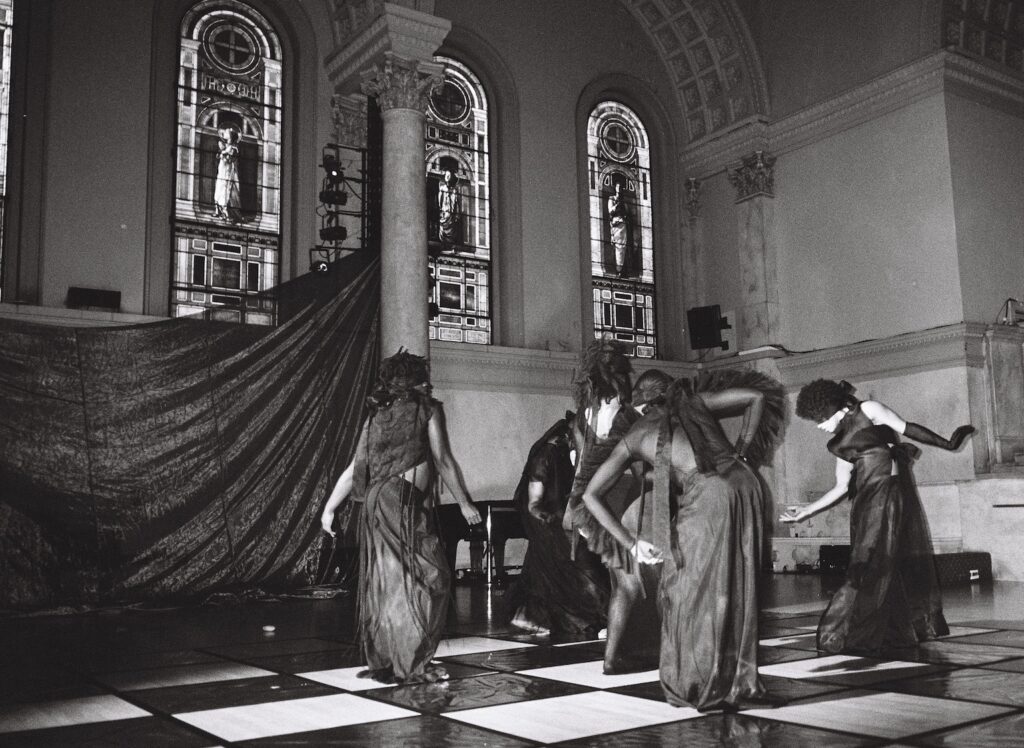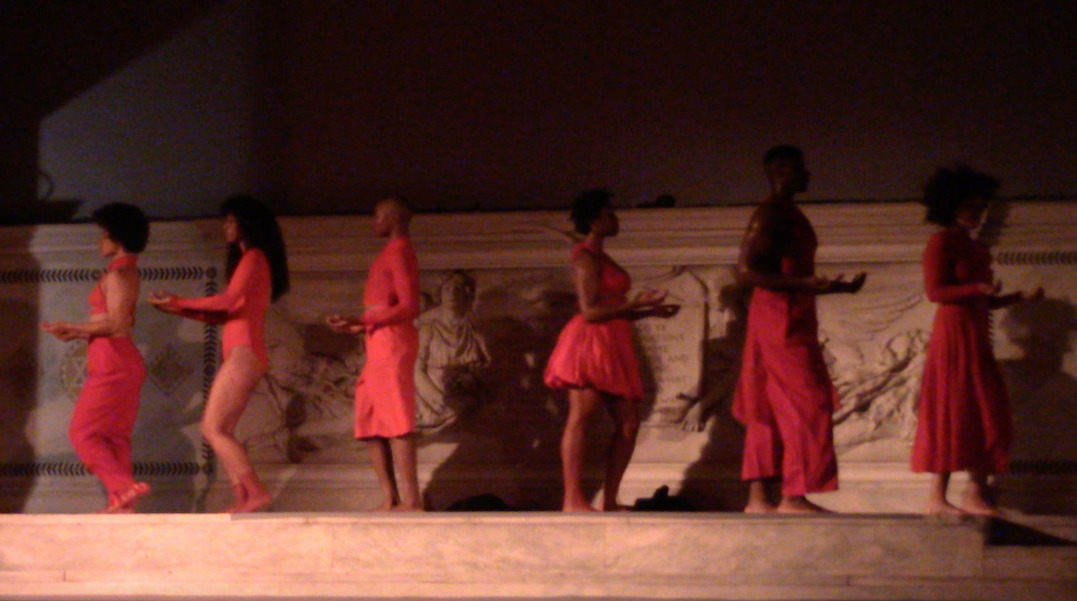Words by Andi Soós.
In the dramatic setting of Judson Memorial Church, Coco Villa stands in a blue spotlight, facing the wall and moving to music that can only be heard through their headphones. As we cannot hear that sound, we are in a different realm, listening to the sounds of a stream. It is hard not to focus on their presence.
Villa’s new piece, I am Swimming with Zaza, is a poetic yet political flow of movement that merges real and imagined Colombian and Jamaican spiritual traditions with fashion design, visual art, and performance. This six-person dance piece evolved from an experimental artistic process spanning several years, and was presented as part of Black Aesthetics, an ongoing series dedicated to Black queer, non-binary and trans artists whose work challenges the notion of contemporary dance.
I first saw a work-in-progress version of I am Swimming with Zaza last November at the Center for Performance Research, followed by a 16mm dance film, Estoy Nadando con Zaza, featuring an excerpt of the same choreography, commissioned by Westlab+Gallery for a film festival organized by Mono No Aware last December. This one-hour performance reflects Villa’s background in dance, fashion, visual art, and moving image: some scenes unfold like sculptural arrangements, while others have a cinematic quality.
The venue, Judson Memorial Church, itself carries a layered history. Built in 1893 on the border between affluent Fifth Avenue and impoverished Lower Manhattan, it was located close to Minetta Lane, which was once known as ‘Little Africa’ and was home to a community of emancipated slaves following the Civil War. By the 1970s, the surrounding streets had become a haven for artists and bohemians, many of whom were priced out by gentrification later on. Since 1955, the church has served as a cultural hub, hosting radical arts and justice movements, as well as the renowned Judson Dance Theater, which has established the venue as a landmark for avant-garde performance. Today, it remains a vital space for experimentation, offering free programming and opportunities for emerging artists to showcase their work. Due to funding cuts and cancellations, Coco Villa turned to the community for help in funding the piece.
As I enter the space, I see that there is a note from Coco on each seat. It is a short story about children playing by the River Nizao in the Dominican Republic. One of the children dives down to retrieve a perfectly sized, pearl-coloured stone that glimmers like the sun beneath the water. As I read the story and recall the Latin American magical realist literature I adored as a teenager, Coco Villa slowly slips into a black dress that was hanging on the altar piece. The space reverberates with the sound of two stones they are rhythmically clashing together.
Like a siren’s call, this sound summons five other dancers onto the stage. Each dancer wears a black floor-length dress and a blindfold. Gradually, the six dark figures fill the space, in which a rectangular zone resembling a chessboard marks the centre. They delicately descend from the altar to the floor, like ghostly figures asynchronously dropping stones on the outer edge of the square anointing the space with audible inhalations and hisses.
The blue light changes to a yellow spotlight that illuminates the dancers as they form a sculpture-like arrangement, clustering at the centre, looping three gestures synchronistically. The four performers slide towards the floor and roll off the stage, as if they would leave the runway of a fashion show. Meanwhile, Coco Villa and Benin Gardner fire the guns they have just formed from their hands. They flex their muscles like bodybuilders and then light up imaginary cigarettes, resembling outlaws in a dreamscape. This scene was familiar from Villa’s aforementioned short film and work-in-progress version, and it had just as powerful an effect in this setting. As they stub out their cigarettes, the stage fades to black and we hear reverberating phantasmic vocals. Akeema Zane, sound designer, guides us through the first interlude: an ethereal soundscape merging into suspenseful minimal piano accompanied by a female voice calmly repeating: whatever I repress, manifests.

Lights rise and the dancers appear wearing white outfits and protective pads on their knees and elbows. The bright, cold lighting and athletic costumes create a starkly different atmosphere to the dark, mysterious opening. Instead of a white flag, Maleek Slade follows the fluidity of a falling red piece of silk, throwing and catching and dropping. At the forefront, Villa empties a bag of sand, as if they are turning a giant hourglass to measure time. Yet the bag also drags the body down.
Like Sisyphus rolling the boulder up the hill, Villa hauls three more heavy sandbags, while dorchel haqq and Mikaela Sinclair Brandon enact tension with a rope and Ny Opong and Gardner take turns carrying and collapsing onto each other. This section evokes both a school gym and a rehearsal space, and feels constructed in contrast to the ritual-like, dark, magical world of the first section. The spotlight falls on Villa, who performs a short solo as the stage glows red and five performers ripple red fabric in a wave-like motion. Villa joins them and together they place the fabric at the centre of the stage. They repeat this with another strip of fabric from the opposite side, and, like blood-coloured rivers merging, the stage transforms. This dynamic set design signals the beginning of the final chapter. The scene fades to black, and the sound continues, like a marimba echoing through the space. After a few minutes of darkness, the performers return dressed in red. The atmosphere becomes more sensual and the choreography unfolds slowly. Some parts evoke Colombian cumbia dance, while others resemble the magical world of rituals, infused with contemporary movement. One by one, the performers exit through a path between the seats until Coco Villa is the only one remaining. Their final solo brings the piece to a close.
The energy of I am Swimming with Zaza can be sensed on many levels. The choreography, sound and costumes – all garments designed by Coco Villa – hold significance to the cultural heritage and practices they grew up with and are reimagining now. As a culmination of an artistic process that blends fashion, visual art, and dance, this piece reflects an approach that fluidly spans genres. One must immerse oneself in Villa’s world. It is magical and otherworldly. We dive beneath the surface to retrieve that shining stone from the riverbed: for just an hour, we swim with Zaza.
Header image by Shrey Mendiratta.
